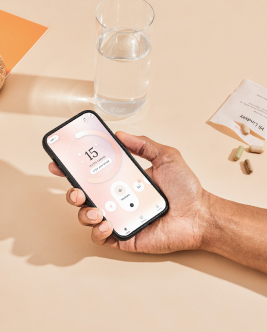science
What’s the Right Daily Amount of Vitamin D for Women’s Health? A Simple Guide
On This Page

In addition to bone health, we now know that vitamin D has many other functions. Learn how you can get enough vitamin D in your health routine.
Why do women need vitamin D3?
Vitamin D3 is an essential fat-soluble vitamin that gets a lot of attention. Not only can the body make it after sun exposure, which makes it unique compared to all other vitamins, but it’s now widely known just how important this nutrient is for many aspects of health.
What are the benefits of vitamin D for women?
- Bone health
- Healthy immune responses
- Prenatal wellness and healthy fetal development
- Mood support
- Healthy energy metabolism
- Reproductive health
Vitamin D is still the subject of a lot of ongoing research. In the coming years, we’ll know even more how it directly affects women’s health in particular.
How much vitamin D should a woman be taking per day?
The current recommended dietary allowance (RDA) for vitamin D is 15 mcg or 600 IU per day for females up to age 70, and 20 mcg or 800 IU for women over age 70. But the Endocrine Society recommends an intake of between 37.5-50 mcg per day (1,500-2,000 IU) for all adults.
Recommended Daily Intake of Vitamin D3 for Women
Many factors affect how much vitamin D an individual requires to achieve optimal levels. Genetics can play a role in a person’s vitamin D receptors (VDR), as can body weight. Vitamin D can be stored in adipose tissue, but is also less accessible that way, which can lead adults with a higher body weight to require more vitamin D. Because health conditions and other factors can influence how much vitamin D3 a person requires, only a medical provider can really answer the question of how much we need by measuring our current levels.
Vitamin D3 Dosage for Women in Different Age Groups
Basic life stage factors impact a woman’s need for vitamin D, like pregnancy, lactation, and menopause. While the RDA is the same for adult women between ages 18-70, this may not be the optimal amount for various reasons.
The tolerable upper limit (TUL) refers to the amount of a nutrient that can be taken without generally leading to potential negative effects. The TUL for vitamin D has been set at 100 mcg (4,000 IU), although this does not mean that this is automatically a safe intake for every person. Your vitamin D3 intake should be based on your health factors and the results of your vitamin D lab work results.
Vitamin D3 Dosage for Pregnant Women
Pregnancy is a nutritionally demanding phase of life. While the RDA does not increase during this time, pregnancy can make it harder for some people to maintain or achieve optimal levels. Many prenatal vitamins include vitamin D3 for this reason.
Vitamin D supplementation during pregnancy may also support healthy outcomes for both mother and child, although research is ongoing with more to be learned. For example, vitamin D supplements (with or without calcium) have the potential to influence maternal health and pregnancy related blood pressure issues. They may also support healthy sleep quality and even fetal bone mineral stores.
The Care/of prenatal vitamin includes 25 mcg (1,000 IU) of vitamin D3 cholecalciferol. Talk to your OBGYN or medical provider to determine how much vitamin D is needed to support your healthy pregnancy.
Vitamin D3 Dosage for Breastfeeding Women
Lactation does not increase vitamin D3 requirements as it does for certain other nutrients, mainly because breast milk does not deplete a mother’s nutrient level. Exclusively breastfed infants may require a vitamin D supplement shortly after birth because breast milk typically does not provide an adequate intake. Infant formula is fortified with vitamin D, so supplements are not usually needed.
Some research found that when pregnant people took 50mcg (2,000 IU) per day of vitamin D instead of 25mcg (1,000 IU), there was a higher amount of vitamin D in breast milk at 2 months postpartum. But only a medical provider can determine what the optimal intake is for a postpartum person. Always check with your baby’s doctor, too, before starting supplements.
Vitamin D3 Dosage for Postmenopausal Women
Postmenopausal women have different nutritional needs than those who are in reproductive years. Even though the vitamin D3 RDA does not increase until after 70, some factors may individually influence a person’s needs.
Vitamin D, together with calcium, is necessary for bone health. In this age group of women it also supports healthy muscles when paired with regular physical activity. It plays a role in urinary health and bladder control, too, along with other general wellness support for a healthy immune system and more.
What is a normal vitamin D level for a woman?
There are different opinions as to what vitamin D levels should be for good health. Lab ranges are classified as:
- Sufficient: 31 ng/mL or higher
- Insufficient: 20-30 ng/mL
- Deficient: 19 ng/mL or lower
Many doctors don’t consider sufficient levels to be the same as optimal, and may instead prefer 40-60 ng/mL as a better range. Only a medical provider can decide what the best target range is for you.
What happens when a woman has low vitamin D?
More than 40% of Americans don’t get enough vitamin D. The impact of low or deficient vitamin D can depend on many factors, but since it’s needed for bone health, immune system function, healthy pregnancy, hormone balance, and more, it can have a big impact for some people. It’s not always possible to tie low levels of vitamin D to specific health issues, but research finds a lot of correlation between low vitamin D and various health conditions.
What are the signs of low vitamin D?
Vitamin D does not always cause signs. But at other times, inadequate or deficient levels may also show up with symptoms, such as:
- Fatigue
- Weak muscles
- Bone issues
- Hair changes
- Thyroid hormone imbalance
Many other things can contribute to or cause these symptoms, so if you experience any of these, check in with your healthcare provider.
Good sources of vitamin D3
There are many ways to support healthy vitamin D levels. The main way that people get vitamin D is through sunshine or supplements, but some foods do contain vitamin D.
Food sources of vitamin D
Few foods contain high amounts of vitamin D. However, you can get some of your vitamin D through dietary sources.
Vitamin D in foods is found as either vitamin D2 (ergocalciferol) or vitamin D3 (cholecalciferol). Vitamin D3 is considered to be more bioavailable because it seems to raise serum levels more effectively than vitamin D2.
Food sources of vitamin D2 include:
- Soy milk (119 IU per cup)
- Milk (115-117 IU per cup)
- Yogurt (116 IU per 8 ounces)
- Kefir (100 IU per cup)
- Fortified orange juice (100 IU per cup)
- Raw mushrooms (100-1,000 IU per cup)
The vitamin D content in mushrooms varies based on the type and the amount of sun exposure they got before being picked.
Food sources of vitamin D3 include:
- Rainbow trout (645 IU per 3 ounces)
- Salmon (383-570 IU per 3 ounces)
- Light tuna (231 IU per 3 ounces)
- Herring (182 IU per 3 ounces)
- Sardines (164 IU per 3 ounces)
- Egg yolk (37 IU per 1 large)
Vitamin D supplements
Vitamin D supplements are a common way that people get this fat-soluble nutrient, especially if they are unable to eat foods that contain vitamin D due to seafood, dairy, or egg allergies. Vitamin D supplements absorb best when they are taken with a meal that contains some healthy fat.
Many multivitamins and prenatal vitamins contain some vitamin D. In some cases, a healthcare provider may recommend an additional vitamin D supplement. When choosing one, always look for products that are third-party tested for purity, non-GMO, free from unnecessary additives and fillers, and manufactured in the U.S.
These are foundational aspects of Care/of’s approach to supplements that you can trust.
Other natural sources of vitamin D
Direct exposure to UVB rays in sunlight is one of the most common ways that people get vitamin D. But for people who have concerns about skin protection, are photosensitive, or have to avoid sun or heat exposure for other reasons, supplements and foods are safer choices.
Even if you do spend time in the sun, many factors influence how effectively the body can make vitamin D, including:
- Air pollution and ozone
- Latitude
- Time of year
- Time of day
- Melanin content in skin
- Age
- Genetics
- Body weight
- Use of sunscreen
- Amount of skin exposed
- Length of time in the sun
You cannot get vitamin D through windows, because glass blocks the UVB rays of sunlight that activate the process. You also need at least 40% of your skin exposed while outdoors in sunlight to synthesize enough vitamin D, and likely need between 5-30 minutes between the hours of 10AM and 4PM to activate the process. For most latitudes in the northern hemisphere, this process will only be effective between May and September. Older adults and people with higher body weights make vitamin D less efficiently, but more sun exposure without sunscreen isn’t recommended, so foods and supplements may need to be used to support healthy levels.
Do women need more vitamin D than men need?
Women do not universally need more vitamin D than men, but certain health factors can increase a person’s need. A healthcare provider can determine how much vitamin D you need for optimal health.
How much vitamin D is too much?
The tolerable upper limit of vitamin D is 100 mcg or 4,000 IU per day. You should never exceed this unless directed by a healthcare provider. In some cases, even the upper limit could be too much for you, so it’s always best to have your healthcare provider check your levels and make recommendations for total intake, including supplements.
Blood levels higher than 150 ng/mL can indicate vitamin D toxicity. While this is a rare condition, it can cause complications with calcium and bone health. Signs of vitamin D toxicity can be:
- Nausea and vomiting
- Dehydration
- Lack of appetite
- Weak muscles
- Fatigue
These symptoms can be caused by many other things. The important thing is to share any health concerns with your doctor and follow your doctor’s recommendations when it comes to vitamin D supplements and to follow through with any lab testing that your provider recommends.
Is there a difference between vitamin D3 and D2?
Vitamin D2 and D3 can both be used in the body, but D2 must go through more steps to make it biologically useful in the body. Vitamin D3 is considered to be more effective at supporting healthy serum levels of vitamin D.
The importance of regular Vitamin D testing for women
Universal vitamin D screening is not recommended, since only certain groups are more likely to have lower levels. Factors that may increase the risk of vitamin D deficiency include:
- Older age
- Darker skin
- Pregnancy
- Gastrointestinal conditions
- Higher body weight
- Weight loss surgery
- Kidney or liver conditions
- Medication use for lipids, weight loss, neurological, or systemic conditions
- Chronic conditions
How is Vitamin D Testing Done?
Vitamin D levels can be checked with a simple blood test, known as 25-hydroxyvitamin D. It can be done as a typical blood draw in a lab or with finger prick testing, either in a lab or with a home test kit. Ask your healthcare provider if your vitamin D levels should be tested.
Understanding Your Vitamin D Test Results
If you get your vitamin D levels tested, one individual lab’s results may differ from another. Your doctor can tell you what an optimal or adequate level is for you. Generally, anything below 20 ng/mL is considered to be deficient, while many healthcare providers consider a wide range of 20-60 ng/mL to be healthy. Depending on the provider and any relevant health conditions, you may be advised that the top end of the range is best.
The Bottom Line
Known previously for its role in bone health, more recent research has suggested a role for vitamin D elsewhere as well, including the immune system, the maintenance of a healthy hormone balance, and in pregnancy. There is still some debate as to what is a healthy level of vitamin D in the blood and how much vitamin D to consume each day. Most adults should aim for about 37.5-50 mcg (1,500-2,000 IU) vitamin D daily. Sun exposure, food sources, and supplementation can help you meet your needs, but always have your healthcare provider verify the best supplement intake for you.



